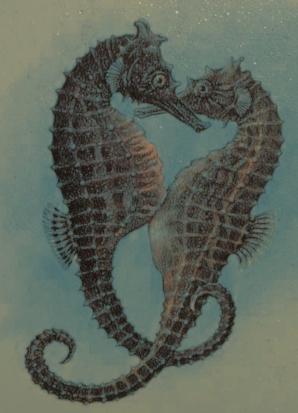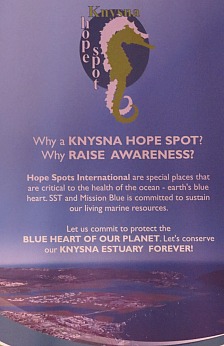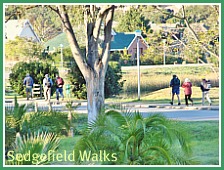The Enchanting Knysna Seahorse
A creature of myth, magic and fable, the iconic Knysna seahorse, Hippocampus capensis, is the only one of nearly 40 of its' species worldwide, found in river estuaries and not in the ocean. Endemic to the Garden Route area of the Western Cape, it is found in only three estuarine systems: the Swartvlei (at Sedgefield), Knysna and Keurbooms (at Plettenberg Bay).
 Knysna Seahorse in a tank at SANPark's offices on Thesen Island, Knysna.
Knysna Seahorse in a tank at SANPark's offices on Thesen Island, Knysna.The tiny little 12cm seahorse used to have a wider range being previously found in Klein Brak, Groot Brak, Goukamma, Groot, Kromme, Kabeljous, and Gamtoos estuaries but they have not been seen in these systems for many years.
Their habitat is restricted almost exclusively to Cape Eelgrass, Zostera capensis which they cling to in relatively shallow water, at depths between 20-50cms, sucking minute crustaceans off submerged plants or those floating by in moving water.
This captivating creature has a horse-like head with a thin snout and a prehensile tail like that of a chameleon and eyes like a chameleon as well, that can rotate independently of each other.
It has a hard outer skeleton like an insect and also an inner bony skeleton like a human. The outer skeleton is made of bony plates instead of scales.
 The Female depositing eggs in the Male's pouch
The Female depositing eggs in the Male's pouchIt has gills and fins like a fish - it is classified as a fish - but swims somewhat awkwardly in a slightly stooped forward position with the tail dragging slightly unfurled behind it. The dorsal fin on its' back propels it through the water and the pectoral fins on either side of the head behind the eyes, steer it in the direction it wants to go. A pair mate for life which is between 8-10 years and they reach maturity at 1 year.
An elaborate slightly clumsy courtship involves tail grasping while
facing each other until the female deposits her eggs in the male’s inflated
pouch which is a mini version of a kangeroos'.
The eggs are safely sealed in the lining of the pouch while the male incubates them, for a period ranging from 14 to 45 days seemingly dependent on water temperature, nourishing them through a capillary network. As they hatch he forcibly expels them from his pouch – up to 200 of the reckless little blighters – and they are left
to fend for themselves seeming to instinctively know what to do because no
further attention or support is forthcoming from either parent.
Within hours of the tiny Knysna Seahorse replicas exiting their father's pouch the female will place another batch of eggs in the male's pouch. For the rest of his life he is a dedicated incubator.
 Male Knysna Seahorse expelling the miniature hatchlings from his pouch.
Male Knysna Seahorse expelling the miniature hatchlings from his pouch.Fortunately the Knysna seahorses are elusive creatures that are able to camouflage themselves by changing colours ranging from pale green to grey to brown to purplish black to blend in with their surroundings.
Some will be preyed upon by crabs, birds and fish, and even other seahorses, but many will survive. They cannot however, protect themselves from environmental degradation like estuary pollution or the loss of their habitat.
In the Sedgefield estuary they are vulnerable in places to disturbance and trampling as fishermen push through the grasses to sandbanks they fish from and when people launch their canoes, kayaks, etc. unaware of their presence.
Unlike Knysa and Keurbooms, the Swartvlei Estuary is an open/closed system and in the last few years the estuary has been more closed than open. This means that seahorses that have had time to establish themselves in an eelgrass area, are vulnerable to being stranded when the closed estuary is opened to the sea when high rainfall inland swells the tributaries flowing in to the Swartvlei and forces the river mouth to open. The water rushes out over a period of 3-5 days resulting in the water levels reducing substantially exposing the eelgrass and flattening it as the water’s edge recedes.
Artificial opening of the river mouth also occurs at times when water in the estuary closed to the sea rises high enough to threaten low lying residential areas and substantial rain is forecast which could threaten such suburbs if the water can't exit the estuary fast enough. This could happen if a high tide is imminent, restricting the pace at which a high volume of water exits the river mouth. SANParks then have to make a judgement call, to allow the Municipality to breach the opening 'artificially" to reduce the disaster of inland flooding.
Sedgefield/SANParks Knysna Seahorse Rescue
In November 2017 and 2018, the SANParks Citizen Science Program led by Clement Arendse engaged local volunteers to assist them monitor these events.
 A pair of Knysna Seahorses foraging together in the tank at SANParks Offices on Thesen Island, Knysna.
A pair of Knysna Seahorses foraging together in the tank at SANParks Offices on Thesen Island, Knysna.Some 4-5 days after the river mouth was breached, teams were created to check out the various eelgrass sites along the Swartvlei Estuary riverbanks and attempt to rescue those seahorses caught-up and stranded in the grasses and return them to deeper submerged parts of their habitat but not too exposed so that they fell prey to hungry predators.
As a result, in 2017 SANParks staff with volunteers collected 900 seahorses, of which 450 were found alive and returned to their habitat.
In 2018, they found only 11 and only one survived.
In 2019, 650 were found live and 650 were found dead. In 2020, the mouth wasn't opened and when it was breached on 25 May 2021 the estuary was very full and spread out and the first day of the seahorse project the water level had not dropped enough for volunteers to access areas where seahorses could need rescuing so the set dates of the rescue bid 27-28 May was extended to 29th.
 The size of a dead seahorse in the palm of my hand.
The size of a dead seahorse in the palm of my hand.Seahorse numbers can be indicative of certain trends, according to Arendse of SANParks Scientific Services.
"If we find
no seahorses it could tell us that the delay in the dropping of the water level assisted
the seahorses in having enough time to escape, or perhaps the population is a
bit lower than last year," he said.
Arendse explained that when the water level drops the seahorses "suddenly get exposed" and instinctively hang onto the eelgrass that flattens on the water's edge and they get buried in it and are unable to escape – which then results in their death.
In an update in 2022 SANParks are pre-emptively sampling the seahorse population in the estuary to discover where they are commonly found so they can focus on these specific areas and rescue them speedily when the drop in water level leaves them trapped in the vegetation.
The SANParks Science Team also do vegetation studies to give them information on how the habitat of seahorses is doing because that will affect the seahorse populations in different areas of the Swartvlei.
 2018 Local Volunteers & SANParks Rangers that took part in the Knysna Seahorse Rescue Project in the Swartvlei Estuary, Sedgefield.
Photo: Yaseen Gaffar, Knysna-Plett Herald
2018 Local Volunteers & SANParks Rangers that took part in the Knysna Seahorse Rescue Project in the Swartvlei Estuary, Sedgefield.
Photo: Yaseen Gaffar, Knysna-Plett HeraldVolunteers searched for seahorses along assigned sections of the Swartvlei banks feeling for the tough little skeletal forms among the grass as they are not always visible. They first had to sign permits to do this work because it is illegal to interfere or remove seahorses from the estuary and you are not allowed to keep one even if it's dead.
Information cards had to state how many live seahorses had been found and returned to the estuary and the dead ones (that didn't revive after placing them in a small bucket of river water for 30 minutes) had to be kept in a bucket and handed in with the score card.
Sedgefield Knysna Seahorse Conservation Strategy
 3 little seahorses found clinging together during the Rescue program - May 2021.
3 little seahorses found clinging together during the Rescue program - May 2021.Arendse noted that the Swartvlei Estuary seems to experience population fluctuations and periodically, mass deaths.
I reckon this could be due to oil spills as the volume of speed boats (and skiing) increase in holiday periods especially in areas close to eelgrass on the Island. Thoughtless (ignorant) residents have been known to spray insecticide on reeds (that obscure their view!) in or near the water which could seriously affect populations of these tiny creatures.
My feeling is that people ought to be notified by estate agents, that they are moving into a conservancy area, if they wish to buy property on the Island and there are conservancy regulations to be considered.
 Knysna Seahorse in Eel Grass
Knysna Seahorse in Eel GrassThis happens to be the only seahorse on the IUCN (International Union for the Conservation of Nature) Red Data List of Vulnerable Species. Locals need to be made aware of how endangered this seahorse is and be conservation-minded with the activities they pursue in the vicinity of its' habitat.
It would help too if SANParks erected a Knysna Seahorse Information Board on the Island or had prohibited areas demarcated in the eelgrass habitat.
References
SANParks Information Board Thesen Island
2017 & 2018 Citizen Science Volunteers with the SANParks Knysna Seahorse Rescue Project


















